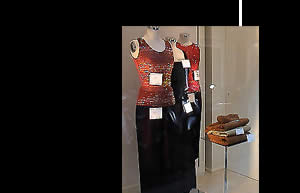|
Italian Fashion
The story of Italian fashion began on 25th February
1951 when Count Giorgini staged a fashion show for an international
audience in Florence.
André Suarès wrote that “fashion is the
best form of farce, though nobody laughs because everyone
takes part”. Dress has always been regarded as a means
of self-assertion in society, an instrunment of personal confirmation
and an important means of communication for individuals and
peoples. It is also the language of desire: a game of flirting
glances and emulation that talks about the evolution of costume,
of modesty and of imagination over the centuries; erotic motivation
is therefore a dominating impulse that determines one’s
choice in clothing.
Giorgini rekindled the myth of the noble classes
by opening up his palace for fashion shows, providing a fantastic,
courtly setting steeped in history for the presentation of
fashion collections. Members of the nobility themselves were
often the ones who wore the dresses, for obvious reasons:
only these princesses and noblewomen, ladies or misses, could,
by their eductaion, customs and culture, wear these fine clothes
properly, and would end up presenting them in the courtly
rooms of their own abodes or in museums alongside sculptures
of fame, the epitome themselves of beauty. Cinema too was
influenced by Italian fashion: a classic case was the wedding
of Linda Christian and Tyrone Power in 1949 for which the
bridal dress was chosen in Rome. All of this went towards
creating a stereotyped yet realistic image of the Land of
the Beautiful, of Art and of Love. Dress took on the role
of a charm for just like in ancient fairy tales, it was the
magic means that made transformation possible.
In the Sixties everything changed: social roles
and status changed in these years of protest and industrial
boom. It was now clearly understood that through dress every
woman could share the magic and interpret the myths of her
own time, meaning that dress had now to be seen as creation
and design. New styles in manufactured garments came onto
the market and women across the world began to dress stylishly
at a low cost. International acclaim for Made in Italy
fashion reached its height with the triumph of “Prêt-à-porter”
in the Seventies and Eighties when Milan became a fashion
landmark, continuing through into the current trends of recent
years inspired by avant-garde art and cultural movements of
the XXth cent.: from Haute Couture to “Prêt-à-porter”,
from the mini-skirt to blue jeans, fashion advances in a tireless
process of regeneration and alternating of styles.
To sum up, the story of Italian fashion unwinds
like a fairy tale for its purpose is fundamentally different
from that of fashion in Paris, London or New York. For Italians,
fashion is an instrument of social redemption whereby class
is determined according to what one wears; elsewhere all of
this is inconceivable: beyond the confines of Italy, fashion
is only a tool for confirming social status.
home
|
|











